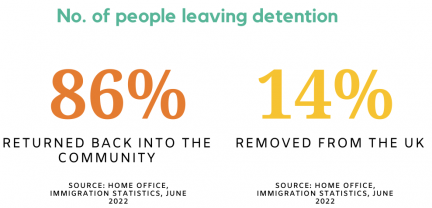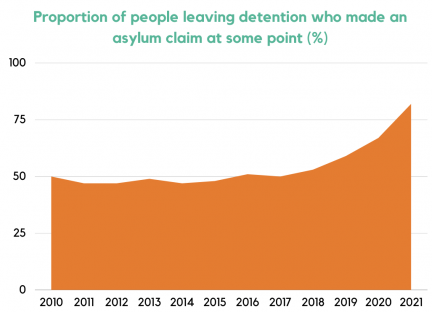Immigration detention Statistics: Year ending March 2022
The Home Office has published its latest quarterly statistics on detention for the first quarter of 2022 (January, February and March).
Instead of being part of another pile of numbers and data, we have analysed it and found some of these ‘insane’ facts. Why are these insane? Why not? Detaining vulnerable people in brutal ways should never be normalised.
The statistics demonstrate that this government is going back to ‘business as usual’ in its approach to immigration detention from prior to the pandemic in 2019. The increasing use of immigration detention is a worrying upward trend, including the detention of vulnerable people without adequate support or consideration of alternatives.
This year - up until March 2022 - 25,282 people entered detention, nearly double the number of the previous year ending in March 2021 (13,044). In a similar upward trend, 24,918 people left detention. At the end of March this year, there were 1,440 people held in detention.
What the statistics don't show for this period is the fact that the Home Office has been using different Immigration Removal Centres with a lack of accountability and transparency. For example, Yarl’s Wood detention centre was used as RSTHF and later reverted to an IRC for men, with different groups of people detained at the centre, including women and children. It is still not yet clear why these changes were made and it undermines the scrutiny and safeguarding mechanisms to protect the vulnerable people being detained.
In the latest immigration statistics, these are the other ‘insane facts’ that stood out -
(These published figures have been analysed and rounded by AVID)
Removal and returns
Only 14% (3,447) of those detained were removed from the UK, which means that 85% (21,258) were returned to the community. These figures can further be examined across the categories of bail; the Secretary of State bail which replaced temporary admission by Schedule 10, Immigration Act 2016, is the highest percentage - up to 75% (18,625). In other words, it is by home office omission that these people should not have been detained in the first place, despite initially finding grounds to detain? Of the rest, 10% (2614) were released under immigration judge bail, and just over 1%(213) left for ‘other’ reasons.
This leads us to question, what is the justification for detaining all of these people in the first place? A total of 21,258 people’s detention served no purpose!

Not only this but people are still being detained for long periods of time, demonstrating the damaging impact of the UK's indefinite detention policy. One of our members, Scottish Detainee Visitors, has written an excellent summary of these figures. Read more here.
The statistics show 20 cases where prolonged detention occurred - the longest being a man who was detained for 1391 days (since 2018). Furthermore, the cost of detention has increased from £86.92 to £107.23 per individual per day. It has cost the Home Office around £135 000 to detain this person.
There remains a lack of transparency over the profits that are made by the private contractors - such as Mitie and Serco - for immigration detention centres. With this in mind, it is difficult not to question who is benefitting from this hugely costly system?
Children in Detention
This year, 93 children, aged 12–17, were recorded detained in the immigration detention estate. All of them were returned to the community, and not one of them was removed from the UK.
Why did this government put these children through this trauma?
- 46 of these children were 17 years old;
- 47 were aged 12-16 years old;
- 41% of children detained were held in Yarl’s Wood IRC, 25% were detained in Tinsley IRC, and 26% were detained in Harmondsworth IRC. The rest were held in other centres, including Dungavel IRC and Brook House IRC.
None of these children were detained in designated family units (Tinsley House Family Unit or Gatwick Pre-Departure Accommodation).
Asylum claims and detention in prison
- 81% of the people leaving and entering detention in the year ending March 2022 had made an asylum claim.
- At the end of March 2022, 1440 people were in detention, of whom 621 were in prison. Prison detention is still a major overlooked part of the detention estate.
How does the safeguarding mechanism work in detention?
- The data shows that 5 pregnant women were detained in this period (down from 7 in 2021 and 20 in 2020)
- 288 people of those in detention at the end of March 2022 had a Rule 35 report. 98% (283) were in receipt of positive Rule 35(3) reports indicating that most of them were survivors of torture.
We want to ask why the move back to an increase in the use of immigration detention? Despite the predecessor government’s promises and progress to reduce the immigration detention estate? The statistics show a worrying regression and upward trend in detaining vulnerable people without adequate support.





